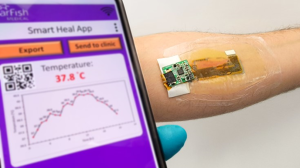 Chronic non-healing wounds cause a significant burden on the healthcare system and are the leading cause of limb amputation.
Chronic non-healing wounds cause a significant burden on the healthcare system and are the leading cause of limb amputation.
Integrating smart bandages within the healthcare system can reduce hospitalization rates and in-clinic wound treatment time, hence reducing the overall burden on the healthcare system.
Introduction
Wounds of any type follow a sequential healing process that results in functional closure without significant complications. However, some wounds will become non-healing chronic wounds (such as bedsores and diabetic foot ulcers) due to improper wound management, aging, and various underlying health issues. Chronic wounds can significantly impact the lives of those affected by them. Not only can they cause physical pain and discomfort, but they can also lead to limb amputations and sepsis.
Traditional wound management techniques, such as visually inspecting and manually assessing the wound, are too subjective and often inadequate. This not only leads to an increased risk of infection and complications but also further delays the healing process and increases the costs of healthcare.
Conventionally, tissue wounds are treated by applying a dressing that has been designed to treat specific wounds and prevent pathogenic microorganisms from infecting the wound bed. In clinical practice, physicians assess the wound status qualitatively based on factors such as the exudate amount, wound and exudate colour, and wound temperature. This assessment requires experienced practitioners to remove the wound dressing frequently, interrupting the healing process.
Understanding our normal wound healing
The natural wound-healing process is a complex and dynamic cascade of cellular signaling and behavioural mechanisms, including hemostasis, inflammation, proliferation, and remodeling.
The process begins with hemostasis, which acts to limit blood loss and contamination at the injury site via the formation of a platelet-fibrin clot. Next, vascular permeability increases, allowing the release of growth factors and immune cells to the wound site, which activates the inflammatory process. Inflammation helps to clean the wound and remove any pathogenic contaminants or debris.
Once the inflammation phase has subsided, the proliferation phase begins. This phase involves the growth of new tissue to cover the wound through the migration of keratinocytes and the formation of new blood vessels for oxygen and nutrient supply. The final stage is remodeling, in which the extracellular matrix is reorganized, resulting in improved wound strength.
Utilizing wound biomarkers for evaluating wound status
The different stages of wound healing are accompanied by distinct markers, such as pH levels, temperature, bacteria or bacterial products, and tissue oxygenation. These markers provide crucial information about the wound’s status. Wearable sensors can be integrated within a conventional bandage to detect these markers and provide information about the wound condition. When these sensors are integrated with bandages, they are called smart bandages.
Smart bandages depend on two main detection techniques, optical (colorimetric/fluorometric detection) and electrical (electrochemical detection), and can be compatible with mobile phones to inform the patient of the real-time wound status. The two most commonly monitored wound biomarkers are pH and temperature.
The pH of a wound’s exudate, or fluid, is a crucial marker that can provide diagnostic information about the wound’s infection status and healing progress. Typically, acute wounds have an acidic environment with pH values between 4-6, which helps to inhibit the growth of pathogenic microorganisms and promote proliferation and remodeling through angiogenesis and epithelialization.
On the other hand, chronic wounds tend to have an alkaline environment with pH values up to 10, which can make the wound environment more favorable for pathogenic bacteria growth and inhibit tissue proliferation. Therefore, monitoring wound pH can help identify the wound healing phase and possible bacterial colonization to enable timely treatment.
Temperature monitoring is a crucial biomarker for assessing the progression of wound healing. The typical temperature range for healthy skin falls between 31.1 to 36.5°C. Prolongation of the inflammatory phase of healing or infection of the wound can cause a substantial increase in temperature at the wound site, reaching values as high as 39-40°C, indicating an abnormality in the healing process.
Hence, monitoring temperature is crucial in providing diagnostic information on the wound status during the inflammatory phase and detecting infections. Infrared imaging is a widely used technique for temperature monitoring; however, its implementation requires frequent removal of wound dressings, which can disturb the healing process.
Different sensors, including colorimetric and electrochemical, have been developed and integrated into bandages for healthcare applications. Colorimetric sensors use pH-sensitive dyes, like brilliant yellow, phenol red, and purple cabbage, or thermochromic materials, like leuco dyes and liquid crystals, that change colour due to protonation or deprotonation of the dye. or into fibres via electrospinning. The wound status can be monitored by image analysis via a smartphone.
The field of flexible electronics is emerging at an exponential rate for the development of biocompatible, wearable sensors capable of wirelessly monitoring wound physiological biomarkers. Electrochemical-based sensors consist of a working electrode and a reference electrode.
The working electrode is either made of or coated with a material that changes its resistance due to the increase or decrease in the mobility of ions passing at different pH levels. One example of a working electrode for pH-sensing is the conductive polymer polyaniline. The reference electrode is usually fabricated from a material (i.e., Ag/AgCl) with a well-known electrical potential.
Takeaways
Chronic non-healing wounds cause a significant burden on the healthcare system that is expected to increase significantly as developed country population demographics age and rates of diabetes and obesity balloon. Integrating smart bandages within the healthcare system can help to reduce overall healthcare costs and improve patient outcomes. In the future, wearable smart bandages could also be combined with drug delivery tools to automatically respond to changes in wound status via controlled and targeted drug delivery.
Image: StarFish Medical
Khaled Youssef is Bio Services Microfluidics Engineer at StarFish Medical.
- SEO Powered Content & PR Distribution. Get Amplified Today.
- Platoblockchain. Web3 Metaverse Intelligence. Knowledge Amplified. Access Here.
- Source: https://starfishmedical.com/blog/revolutionizing-wound-care-smart-bandages-with-wearable-sensors/



